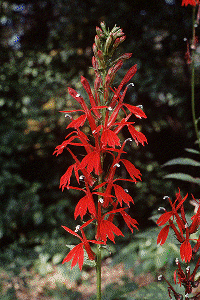
 In
late summer the brilliant scarlet of Cardinal Flower flashes from the marshes,
stream banks and low woods. Called "America's favorite" and "spectacular",
its extremely showy blossoms can be recognized at considerable distance.
Few native plants have flowers of such intense color as this common herbaceous
perennial.
In
late summer the brilliant scarlet of Cardinal Flower flashes from the marshes,
stream banks and low woods. Called "America's favorite" and "spectacular",
its extremely showy blossoms can be recognized at considerable distance.
Few native plants have flowers of such intense color as this common herbaceous
perennial.
The blossoms are delicate, gradually opening from bottom to top on two to four foot spikes. Five petals are united into a scarlet two-lipped corolla. The lower lip has three very prominent lobes; the upper lip has two small ones. Five stamens are joined forming a red tube around the style and are topped by bearded anthers which form a mustache-looking brush.
Beneath the flower spikes are numerous dark green leaves, tapered at both ends. A moderately tall plant, stout and erect, it is the favorite of our ruby-throated hummingbird, who obliges as a pollinator. The many seeds come in two-celled pods which open at the top.
Cardinal flowers can be grown in full sun or very light shade but probably grow best in filtered light. Mulch to keep the roots moist. Seeds planted in the summer form rosettes of foliage which stay green through the mild winter of the South. Be careful to keep leaves and debris from smothering these rosettes.
Beautiful but deadly, this plant has been used as a medicine but is also very poisonous. It contains fourteen alkaloids similar to those in nicotine. Extracts of the leaves and fruit produce vomiting, sweating, pain and finally death.
The Cardinal Flower is a member of the Bluebell Family, Campanulaceae. It was named after the Flemish botanist, Matthias de L'Obel (1538-1616).
